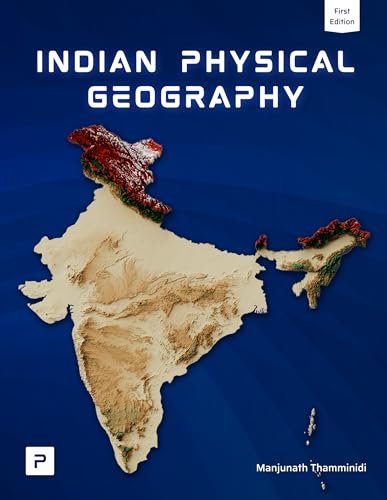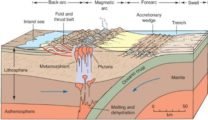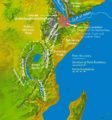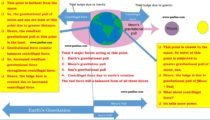
British Type Climate (European Maritime Climate)
Subscribe to Never Miss an Important Update! Assured Discounts on New Products!
Must Join PMF IAS Telegram Channel & PMF IAS History Telegram Channel
Last updated on April 19, 2024 7:28 PM
British Type Climate
- Westerlies come all the year round.
- There is a tendency towards an autumn or winter maximum of rainfall.
- Light snow falls in winter.
- Ports are never frozen but frosts do occur on cold nights.
- The seasons are very distinct .
- And the climate is very favorable for maximum human output.
British Type Climate or Cool Temperate Western Margin Climate or North-West European Maritime Climate.
- The cool temperate western margins are under the influence of the Westerlies all-round the year.
- They are the regions of frontal cyclonic activity [Temperate Cyclones].
- This type of climate is typical to Britain, hence the name ‘British Type’.
- Also called as North-West European Maritime Climate due to greater oceanic influence.
Distribution of British Type Climate
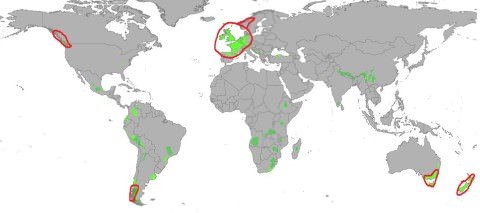
Europe
- Most pronounced in and around Britain.
- In Europe the climate extends inland some 2,000 km.
- Climatic belt stretches far inland into the lowlands of North-West Europe (northern and western France, Belgium, the Netherlands, Denmark, western Norway and also north-western Iberia).
North America
- Confined mainly to the coastlands of British Columbia. [high Rockies prevent the on-shore Westerlies from penetrating far inland]
Southern Hemisphere
- The climate is experienced in southern Chile, Southern Australia, Tasmania and most parts of New Zealand.
British Type Climate
- Moderately warm summers and fairly mild winters.
- Rainfall occurs throughout the year with winter maxima.
Temperature
- The mean annual temperatures are usually between 5° C and 15° C.
- Winters are abnormally mild. This is because of the warming effect brought by warm North Atlantic Drift.
- Sometimes, unusual cold spells are caused by the invasion of cold polar continental air (Polar Vortex) from the interiors.
Precipitation
- The British type of climate has adequate rainfall throughout the year with a tendency towards a slight winter maximum (due to frontal cyclones).
- Western margins have the heaviest rainfall due to westerlies.
- Relief can make great differences in the annual amount. This is particularly significant in New Zealand where the western margins are subjected to heavy orographic rainfall whereas the eastern Canterbury plains receive comparatively less rainfall due to rain-shadow effect.
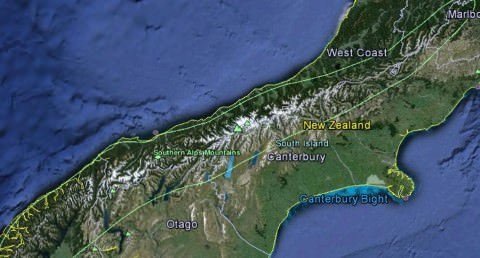
The seasons
- As in other temperate regions there are four distinct seasons.
- Winter is the season of cloudy skies, foggy and misty mornings, and many rainy days from the passing depressions.
- Spring is the driest and the most refreshing season when people emerge from the depressing winter to see everything becoming green again.
- This is followed by the long, sunny summer.
- Next is the autumn with the roar of gusty winds; and the cycle repeats itself.
- This type of climate with its four distinct seasons is something that is conspicuously absent in the tropics. [Rainforest == Only Rainy season, Tropical Monsoon == Summer, Winter and Rainy, Tropical Savanna == Summer (rains) and Winter]
Climate Graph British Type Climate
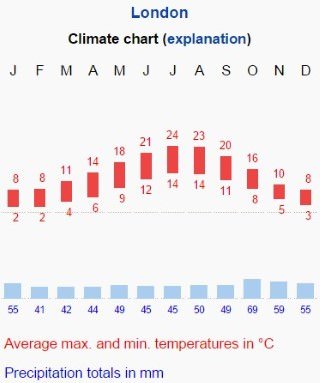
Natural Vegetation in British Type Climate
- The natural vegetation of this climatic type is deciduous forest.
- The trees shed their leaves in the cold season.
- This is an adaptation for protecting themselves against the winter snow and frost.
- Shedding begins in autumn, the ‘fall’ season.
- Some of the common species include oak, elm, ash, birch, beech, and poplar.
- In the wetter areas grow willows (Light weight cricket bats are made from willows. In India willows are found in Kashmir).
- Higher up the mountains in the Scandinavian highlands, the Rockies, southern Andes and the Southern Alps of New Zealand, the deciduous trees are generally replaced by the conifers which can survive a higher altitude, a lower temperature and poorer soils.
Economy in British Type Climate
Lumbering is quite profitable
- Unlike the equatorial forests, the deciduous trees occur in pure stands and have greater lumbering value.
- The open nature of the forests with sparse undergrowth is useful in logging operations.
- Easy penetration means much cost can be saved in the movement of the logs.
- The deciduous hardwoods are excellent for both fuel and industrial purposes.
- In Tasmania, the temperate eucalypts are also extensively felled for the lumbering industry.
- Higher up the mountains, conifers (softwood) are felled and transported to paper and pulp industry. They are extensively used in cardboard making.
Industrialization
- The regions are highly industrialized with high standard of living.
- The countries are concerned in the production of machinery, chemicals, textiles and other manufactured articles rather than agriculture, fishing or lumbering, though these activities are well represented in some of the countries.
- Fishing is particularly important in Britain, Norway and British Columbia.
- Britain, France and Germany have significant mineral resources and are heavily industrialized.
- Ruhr region in Germany, Yorkshire, Manchester and Liverpool regions in Britain are significant for wide ranging manufacturing industries.
- Automobile industry is the most significant. (BMW, Volkswagen, Audi, Mercedes-Benz and many other world leading car manufacturers have their headquarters in Germany).
- Industries based on dairy products thrive in Denmark, Netherlands and New Zealand.
- Tasmania is important for merino wool production. Wool produced here is exported to textile factories in England, Japan, China etc..
Agriculture
- A large range of cereals, fruits and root crops are raised, mainly for home consumption rather than for export.
- North-West Europe, which includes some of the most crowded parts of the globe, has little surplus for export. It is, in fact, a net importer of food crops, especially wheat.
Market gardening
- All the north-western European countries are highly industrialized and have high population densities. There will normally be great demand for fresh vegetables, eggs, meat, milk and fruits.
- As the crops are perishable, a good network of transport is indispensable. The produce are shipped by high speed trucks (truck farming, which is commonly used in the United States)
- In Australia, high-speed boats ply across the Bass Strait daily from Tasmania to rush vegetables, tomatoes, apples and beans to most of the large cities in mainland Australia. It is no wonder the Australians nicknamed Tasmania the ‘garden state’.
Mixed farming
- With the rise of industry, more arable farms are being devoured by factories and wheat is now a net import item in Europe.
- Throughout north-western Europe, farmers practice both arable farming (cultivation of crops on ploughed land) and pastoral farming (keeping animals on grass meadows).
- Amongst the cereals, wheat is the most extensively grown, almost entirely for home consumption.
- The next most important cereal raised in the mixed farm is barley. The better quality barley is sold to the breweries for beer-making or whisky distilling.
- The most important animals kept in the mixed farm are cattle.
- The countries bordering the North Sea (Britain, Denmark, the Netherlands) are some of the most advanced dairying countries where cattle are kept on a scientific and intensive basis.
Dairying
- The temperate western margin type of climate is almost ideal for intensive dairying.
- Cheese is a specialized product of the Netherlands.
- From Denmark and New Zealand comes high-quality butter.
- Milk is converted to cream, which is less perishable than fresh milk and is exported to all regions across the globe.
- Fresh milk is converted into various forms of condensed or evaporated milk, and exported around the world for baby-feeding, confectionery, ice-cream and chocolate making.
Beef cattle
- Besides dairying, some cattle are kept as beef cattle.
- In Argentina or Australia, meat production is the primary concern.
- The high rate of beef consumption in Europe necessitates large imports of frozen and chilled beef.
- The pigs and poultry act as scavengers that feed on the left-overs from root-crops and dairy processes. In this way, Denmark is able to export large quantities of bacon [cured meat from the back or sides of a pig] from pigs that are fed on the skimmed milk, a by-product of butter-making.
Sheep rearing
- Sheep are kept both for wool and mutton.
- Britain is the home of some of the best known sheep breeds.
- With the greater pressure exerted on land by increased urbanization, industrialization and agriculture, sheep rearing is being pushed further and further into the less favored areas.
- Britain was once an exporter of wool (But now it imports from Australia). But today exports only British pedigree animals to the newer sheep lands of the world (Australia).
- In the southern hemisphere, sheep rearing is the chief occupation of New Zealand, with its greatest concentration in the Canterbury Plain [The rain shadow region]. It has been estimated that for every New Zealander there are 20 sheep.
- Favourable conditions include extensive meadows, a mild temperate climate, well-drained level ground, scientific animal breeding, the development of refrigeration –enables chilled Canterbury lamb and Corriedale mutton to reach every corner of the globe.
- Though New Zealand has only 4 per cent of the world’s sheep population, it accounts for two-thirds of the world’s mutton exports, and one sixth of world wool exports.
- In Tasmania and southern Chile, sheep rearing has always been a predominant occupation with surplus sheep products for the international trade.
Other agricultural activities
- Amongst the food crops, potatoes feature prominently in the domestic economy of the cool temperate regions.
- It is the staple food in supplementing wheat or bread for millions of people.
- In terms of starch, potato yields far more food than any cereals and can be cultivated over a wide range of climatic and soil types.
- Today almost two-thirds of the world’s annual production of potatoes comes from Europe, of which Poland, Germany, France and UK are the major producers.
Beet Sugar
- Found almost exclusively in north-western Europe (including European Russia) and parts of U.S.A.
- The need for such a crop was greatly felt during the Napoleonic Wars around 1800 when military blockades caused a scarcity of sugar.
- The beet is crushed for sugar and the green tops are used as animal fodder.
- The crop thrives best in the warmer and drier east of Britain and in mainland Europe. The highest sugar yield is obtained when the autumn is both dry and sunny.
QUESTIONS
Write a geographical account of the following economic activities.
- Mixed farming
- Beet sugar cultivation
- Cool temperate orchard farming
- Sheep rearing
- Woollen textile industry
Give an explanatory account of any two of the following.
- Sheep outnumber the population of New Zealand by 20:1.
- No country produces and exports more wool than Australia.
- Market-gardening is a product of urbanization.
Primary References: NCERT Geography, Certificate Physical and Human Geography [Amazon and Flipkart]
Last updated on April 19, 2024 7:28 PM





